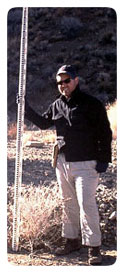
| Project Title: Quantitative Geomorphic
Modeling Mendenhall Fellow: Jonathan Stock, (650) 329-4968, jstock@usgs.gov Duty Station :Menlo Park, CA Start Date: October 3, 2003 Education: Ph.D. (Geomorphology), University of California - Berkeley, 2003 Research Advisor: Kevin Schmidt, (650) 329-5302, kschmidt@usgs.gov |
 |
 |
Project Description: Changes in climate and land management are altering vegetation across Earth's surface, most visibly in arid regions like the Great Basin or Mojave. These changes alter erosion rates and sediment transport at human timescales because of the role that vegetation plays in stabilizing otherwise mobile sediment. Where these effects aggregate over large regions they alter natural hazards and landscape ecology (e.g., arroyo cutting), with economic consequences. Alluvial fans in the aridlands of the western United States are fan shaped landforms that are profoundly sensitive to small changes in climate and vegetation, which alter the amount of runoff and erosion during violent, episodic storms. Resulting torrential flash floods sweep large quantities of eroded sediment down these steep fan channels (2-8% slope), destroying structures or habitations along their path. Our knowledge of the mechanics of erosion and sediment transport during these events remains largely speculative because of their infrequency, and the lack of detailed studies of channel hydraulic properties. For instance, we lack field calibrated expressions for flash-flood sediment transport across alluvial fans. |
Under this project field measurements and experiments are being used to quantify channel and hillslope flow hydraulics and sediment flux across alluvial fans in the Mojave desert and Great Basin. The conditions under which sediment moves are being explored using analog channels and flumes to simulate the shallow, super-critical flow that many observers have described on alluvial fans during storms. These observations will lead to an appropriate sediment transport formula, which may be significantly different than the common excess shear stress model proposed for most perennial rivers. The goal of the project is to connect a mechanistic description of event sediment transport with measured fan hydraulic geometries in a way that predicts the existing fan shape. By connecting fan transport processes with form (e.g., Fig. 2), the plan is to illustrate how fan long-profiles vary with different climates, vegetation and tectonics. Eventually, a mechanistic understanding of sediment generation and transport across alluvial fans will allow us to provide advance estimates of regional landscape changes.
|
|
Previous Profile | Project Profiles | Next Profile |
|
<URL:http://geology.usgs.gov/postdoc/profiles/stock.html>
Maintained by: Eastern Publications Group Web Team
Last updated 08-05-2004 (krw)